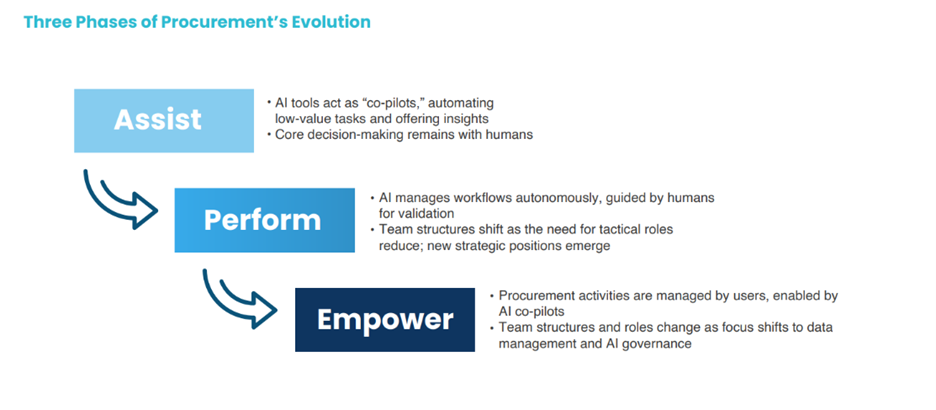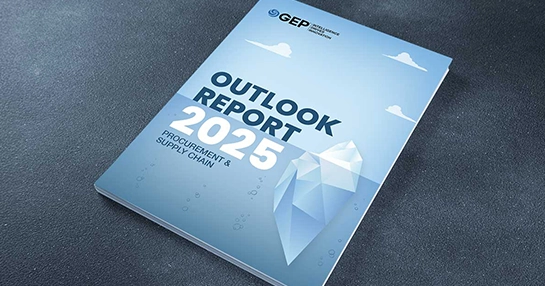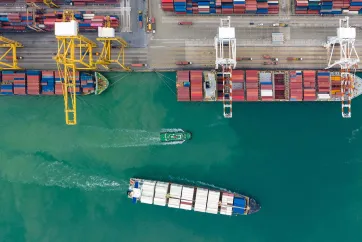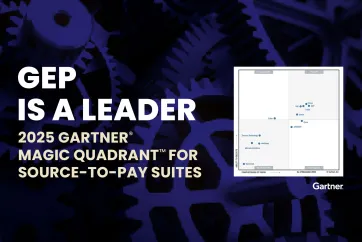
Getting Ready for AI-Powered Procurement Transformation
- AI-powered transformation in procurement is likely to occur in three phases.
- Each of these phases will be more transformative than the previous one, with AI’s capabilities expanding and leading to increased automation.
- While AI continues to automate tasks, there is still a human-in-the-loop to validate the output.
March 26, 2025 | Procurement Software
How will the procurement function operate three or five years from now? With the adoption of AI-powered technology, how will procurement’s role and capabilities change?
The short answer: AI will bring about a significant transformation in procurement.
While all business functions will benefit from innovations in AI, few are likely to transform as big as procurement. Not surprisingly, AI use cases in procurement are increasing almost every day.
The long-overdue incorporation of advanced technology and tools has also got industry experts excited.
Wayne Clarke, vice president of consulting at GEP has no doubt that AI will revolutionize procurement. “As AI-driven innovations mature and more disruptive use cases emerge, procurement as we know it today will be upended, replaced by something more powerful, efficient and integrated with AI systems,” he says in this article.
What Will Change in Procurement
The current operating model in procurement relies heavily on human expertise. This will give way to a tech-driven model that automates many of the routine, time-consuming tasks, allowing the human workforce to focus on more strategic and value-adding tasks.
Automation will redefine supplier selection, contract management, supplier performance management, invoice processing and many other processes.
But, more important than automation, AI can quickly analyze large datasets and generate actionable insights. Procurement can leverage this capability to make informed decisions, anticipate market shifts and identify savings opportunities. They can proactively identify risks and take preventive steps to mitigate their impact.
“AI will create more empowered procurement teams equipped with advanced tools, fundamentally reshaping the system of roles, workflows and controls. This new model will greatly exceed today’s standards in quality, speed, value and cost efficiency,” says Wayne.
How Will the Change Occur
There is no doubt that procurement operations will fundamentally change. But the pace of this change can vary for different businesses.
AI-driven transformation in procurement will occur in three phases, each more transformative than the last.
1. The Assist Phase:
In the initial phase, AI tools act as co-pilots, automating low-value tasks and providing insights for making informed decisions. There is still high reliance on human judgement and decision-making. This means there is little impact on the procurement team’s size or structure.
In this stage, AI is primarily used to augment human capabilities, improve productivity, and deliver incremental cost savings. For example, chatbots answer supplier queries, while teams use AI tools to score RFP responses and analyze bids. “In phase 1, the tools aren’t useful enough to meaningfully replace humans,” says Wayne.

2. The Perform Phase:
The expansion of AI capabilities in this phase enables more comprehensive automation and integration of procurement processes. More advanced AI solutions can now manage end-to-end procurement workflows and perform tasks like category strategy development, contract renewals and demand forecasting. Interestingly, there is still a “human-in-the-loop” whose primary job is to validate the outputs.
The team’s structure will begin to change in this phase, with tactical roles diminishing and new strategic roles emerging. These new roles will focus on interpreting AI-driven insights, managing more complex categories, and ensuring continuous improvement in AI outputs. Teams will need to incorporate new competencies that emphasize data analytics, AI fluency, and business insights.
3. The Empower Phase:
In the final phase, procurement teams focus on complex, strategic initiatives, allowing business users to leverage powerful AI tools for routine procurement tasks. This means that end-users can handle common procurement tasks with minimal human intervention.
Intuitive, AI-driven platforms can handle low-complexity purchases, supplier evaluations, and even contract negotiations. This rise of self-service procurement will further reduce the need for traditional roles in procurement. Instead, the competencies in focus will be highly specialized data management and AI governance.
This phase will see a big shift in the operating model, with category teams focusing on value chain optimization and business partner teams delivering insights and strategies aligned with operational goals.
Start Preparing for the Change
You must start preparing by having a clear vision and strategy. Secure cross-functional support to navigate the early stages of transformation.
To get ready for AI-powered procurement transformation, you must first invest in master data management and governance structures. Ensure that you have clean, accessible data to feed into AI tools.
At the same time, you must also invest in upskilling teams. Get your workforce ready to derive the maximum benefits of technology. AI fluency and advanced business analytics are the new skillsets that will allow teams to work alongside AI platforms.
Finally, with all this evolution, procurement will no longer be judged on cost savings alone. New performance metrics will include agility in responding to supply disruptions, greenhouse gas reductions and the volume of touchless transactions.
Get the GEP Outlook Report 2025 for more insights.



